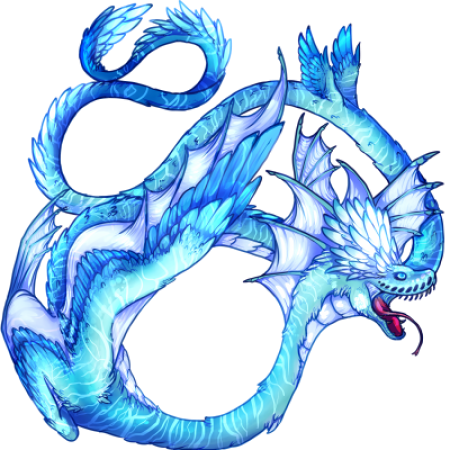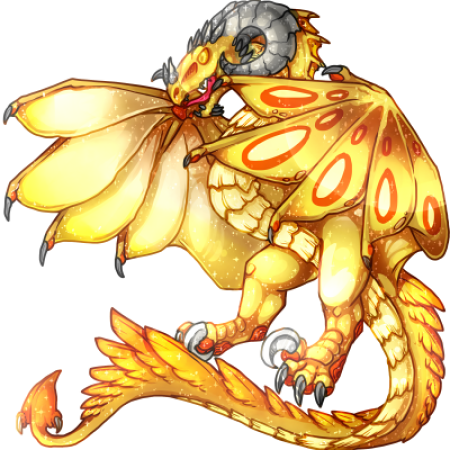Dragons
'Interacting with another dragon can be the last thing you ever do, if you do not know how their boundaries and your place in their life. Do not approach a stranger without first making it clear you mean them no harm, and second - that you've brought them a gift to win them over.'There are eight classes of dragon:-Draconian Guide on Interacting with Other Species
- Drefni - Small, stout dragons, bearing four legs and no or one pair of wings, blessed by the deity of Life Drefni Naruta.
- Jasini - Medium to large sized four legged dragons, bearing one pair of wings and horns, blessed by the deity of Nature Jessa Jasini.
- Turom - Large sized two legged dragons (back legs), with one to two pairs of wings, blessed by the deity of Light Felixs Turom.
- Turiki - Large sized no legged dragons with at least two pairs of wings, but up to five pairs, blessed by the deity of wind, Cellon Turiki.
- Ludiculous - Large sized dragons with a pair or two of wings, and a pair of front legs, blessed by the deity of water, Auguan Ludiculous.
- Luse - Medium to large sized dragons with two to three pairs of legs and no wings, blessed by the deity of earth, Rethain Lu'se.
- Dalduious - Medium to large sized dragons with two heads, two to four pairs of legs, and one to two pairs of wings, blessed by the deity of fire, Besir Dalduious.
- Zurath - Small to Medium sized dragons with two pairs of legs and a long, snaking body, and none to one pair of wings, with no specific blessing, but may be blessed by the Ascendant One.
- All dragons have an innate connection to magic, however the strength of this connection may vary based upon their emotional state, confidence in their ability, and random chance. Some of the strongest draconian mages rely entirely upon their emotions to cast magic, and some of the most destructive and dangerous creatures in the veil have been dragons who channeled their power through rage.
- Dragons typically show thanks by giving physical offerings and gifts, usually of food or very rarely valuable objects where the action they are repaying is of great importance.
- Dragons will leave random objects in the way of those they feel they owe, hoping for the recipient to accept their gift. If this is ignored, this behavior may continue almost obsessively as they keep trying to earn their worth.
- Dragons favor food with strong savory flavors, spicy flavors, and food heavy in fats and sugars; the more energy content in it, the better it is.
- Dragons may occasionally hibernate, usually younger dragons will spend the months in a sleep like state if they do not have enough provisions to sustain themselves.
- Young dragons will be kicked out of their village as a rite of passage and may move into the wilderness for a few years, until they find their calling or a suitable other dragon to spend their life with.
- Dragons who do chose a partner will consider them a chosen soulmate, and generally do not break these bonds unless death or corruption has befallen their mate.
- Dragons occasionally form their own societies in the northern mountain wilderness, where they mingle with only their own species, in deep caverns that have been dug by hand. These societies tend to stray away from the main castle and city societies.
- Dragons typically take up a single craft when in a society, and typically specialize in candle and soap work, artistic endeavors, wood and stone carving, and gemstone and jewelry manufacturing.
- Some dragons will incorporate their magical abilities into their craft, and use them to better the product they produce.
- Dragons without the ability to fly often spend their time in subterranean caverns, carved at the base of mountains and going below the earth, while dragons that can fly reside on cliffside homes.
- A typical dragon home is carved into the earth, by hand, during their youth exile, or found abandoned from a previous tenant. These homes have a central hearth, a food storage room, and a higher located den that is usually lined with down feathers or soft plants. These homes will house only one mated pair and only their younger children.
- Dragons typically cut off contact with their family before being exiled, and do not form strong family bonds outside of their mate and younger children.
- Dragons of all kinds can be highly territorial if not living in a communal society, and may attack other species and by passers of their home if disturbed.
- Dragons are the most instinct driven species in the Veil, and often can resemble more feral animal than civilized society member if left without societal contact for too long.
Basic Information
Biological Traits
Dragon wings come in three forms: Fully feathered, half feathered, and fully webbed. Fully and half feathered dragons may have feather growths also protruding from their hips, hackles, cheeks, tail, and spine. Fully webbed dragons do not typically possess feathers on any other part of their body.
Dietary Needs and Habits
Dragons find it easy to eat whatever food they come across, although some dragons may find it hard to personally digest plant matter and may find themselves accidentally setting their den on fire after consuming them.
Additional Information
Social Structure
Dragons typically do not interact with each other unless they are in a village or commune. Communes may involve multiple mated pairs of dragons and each may contribute different crafts and skills towards the survival of the society, while villages are interspersed with other species and can include unpaired dragons. Additionally, dragons within villages are less feral and tend to not follow the customs of a commune, and are generally more carefree and tame.
Facial characteristics
All subspecies of dragons may have varying types of horns upon their head, along with feather crests, manes, and small tufts of hair.
Geographic Origin and Distribution
Dragons are found throughout all regions of the Veil, although certain subspecies are adapted better for specific locales.
Average Intelligence
Dragons can be very intelligent if they spend their time in the central cities, however they may lack the ability to properly process and handle their emotions no matter how civilized they may appear. Dragons that spend their time outside of society are typically good at problem solving, but may struggle at empathy and kindness, and can be incredibly dangerous as they may take whatever opportunities available to them.
Perception and Sensory Capabilities
Dragons can typically breathe a flame, chilling wind, spit acid, lightning, or plasma from their mouths, although it is not rare for a dragon to be born without a form of this natural defense.
Dragons that possess wings can fly, usually with varying levels of skill depending on their own personal practice.
Symbiotic and Parasitic organisms
Amphibolds may inhabit the abandoned tunnels of dragons after a local group has moved out.
Photo by marco allasio from Pexels
The call of the wild flame lives within each dragon. The only choice they get is to feed it or starve it.
Scientific Name
Draconis Nativus
Origin/Ancestry
Created by Hand from Each of the Seven
Lifespan
130-140 years
Average Height
Varies between Subspecies
Average Weight
Varies between Subspecies
Average Length
Varies between Subspecies
Average Physique
Dragons are typically very physically strong, and able to break bones with their jaws and paws with ease, no matter the subspecies.
Body Tint, Colouring and Marking
Dragons can come in a variety of colors, and are typically not limited by their subspecies or lineage.
Geographic Distribution
Remove these ads. Join the Worldbuilders Guild


















Comments